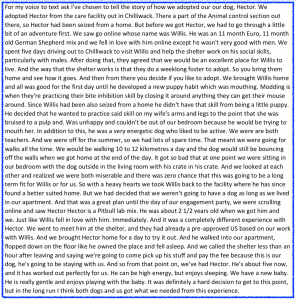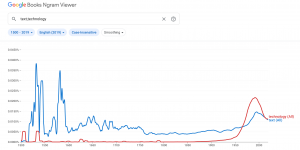I chose to use the voice-to-text software included in the Microsoft Word program as part of the 2019 software package, Microsoft Office. The software had an option to use auto-punctuation, which I chose to turn on.
The story that I chose to tell was that of how my wife and I adopted our dog, Hector. The transcript of the story as recorded by the software can be seen below:

How does the text deviate from the conventions of written English?
The text differs significantly in the organization of ideas. Paragraphs are often used to separate ideas or changes in topic. The voice-to-text software was not able to make such distinctions, creating a larger body of text.
Another significant difference from conventional written English is the lack of punctuation other than periods. For example, there are several sentences that would require a comma to indicate a brief pause, however, the software does not capture the short pauses or erroneously interprets them as an end of the sentence.
There are deviations in the formal minutia of grammar, such as verb-subject agreement throughout the text, “with a heavy hearts”, or the incorrect article usage of “a pre-approved US based on our work”.
What is “wrong” in the text? What is “right”?
One error made in the text is that there are some homonyms that are substituted for the correct words. For example, towards the beginning of the story, the voice-to-text software captured the words, “There a part”, rather than the spoken “They are a part”. This can change some of the meaning of the spoken story.
Another thing that is incorrect in the text is repeated sections of the text. For example, “with his crate in his crate”. This stems from corrections in the oral storytelling and the software being unable to distinguish the difference between a correction and the original story.
The voice-to-text software managed to mostly capture the words as spoken aloud, enough to maintain the content and ideas of the story. There are some small errors in the written language, as discussed, but the idea is still conveyed.
What are the most common “mistakes” in the text and why do you consider them “mistakes”?
There is a commonly held rule in written language that sentences should not begin with the word “and” in order to prevent run-on language and hinder the development of ideas in written text. The software captured the informality of the spoken language that I was using, resulting in sentences that start with “and”. I consider this a mistake because it was a lesson taught to me in my formal education while learning to write and is something that I maintain with my students today.
Another mistake contained within the text is there are often words substituted incorrectly that obscure the meaning of the spoken sentence. For example, the software’s usage of the word “modding” rather than “mouthing”. The software attempts to find a homophone for what the audio sensor picks up, confusing the meaning.
There are several words throughout the story that do not contribute to the overall meaning of the sentence, such as “definitely” or “really”. As a teacher and student that writes primarily in an academic tone, I would consider these types of words mistakes and would attempt to remove them during an editing phase of writing. This would be as a result of my experiential knowledge with the written word.
What if you had “scripted” the story? What difference might that have made?
If I had scripted the story, I would have made a conscious decision in my word choice to avoid some of the common homonym mistakes or repeated words that take away from the flow of the story. Scripting the story may have also allowed me to remove any clarifications of my spoken language that were recorded as repeated phrases since it would have been more of a performance than an oral storytelling session.
If I had scripted the story, the result would probably have been a more formal and academic-sounding body of text. When writing, I tend to opt towards a formal tone due to my educational experiences and professional occupation, whereas my spoken tone deviates towards the informal. If I had simply read the script, my spoken word would match my written output.
In what ways does oral storytelling differ from written storytelling?
As discussed above, oral storytelling tends to occupy an informal space in language. I find that this is due to the usage of the first-person tense, increased word count, and more of a focus on the flow of the language rather than the correctional grammatical usage. There also are opportunities for clarification or correction in spoken language that simply does not exist in the same manner when writing, as evidenced by repeated sections in the voice-to-text task. The software cannot make that distinction, whereas a listener would not confuse it for part of the story.
Another significant difference is the cadence of the spoken word. Without the ability to hear the inflection or tempo of the voice, the personal emotion/tone is completely removed from the written product. This could create more of a detachment from the subject of the text or from the author’s perspective.
Oral storytelling is often between individuals who have a shared perspective or life experiences, allowing for things that remain unspoken to shape the understanding of the oral text. In writing, these assumptions do not always exist, making it necessary to provide any details as formal writing to help crystallize the understanding. Traditional oral storytelling also would require the audience to be present with the speaker, allowing them to ask questions or seek clarifications in real-time. The speaker would also benefit from feedback from their audience, which is something that writing does not offer. The reader and writer can often be separated by time and distance, obscuring some understanding.





